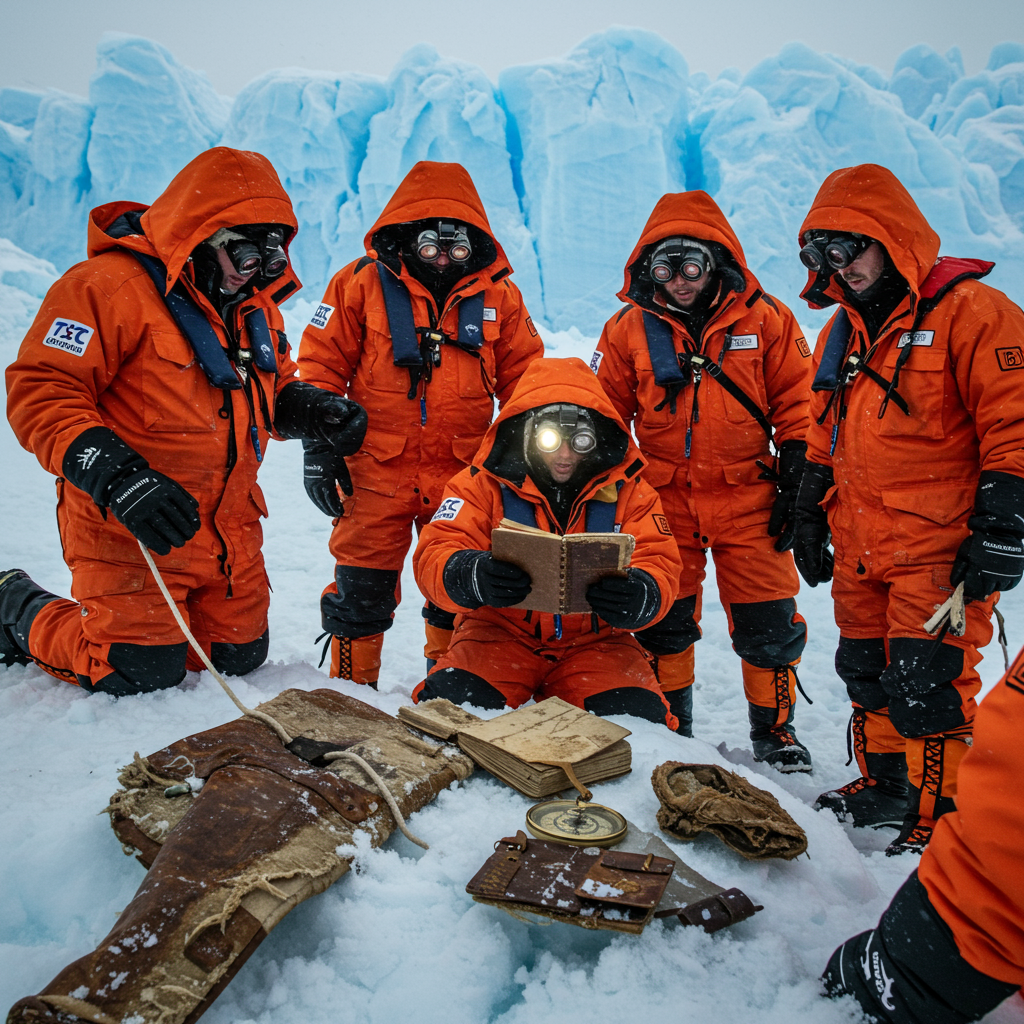A profound mystery spanning 66 years has finally found closure. In a remarkable discovery, the remains of British meteorologist Dennis “Tink” Bell, who vanished in Antarctica in 1959, have been recovered from a receding glacier. This poignant find, confirmed through advanced DNA analysis, not only brings peace to Bell’s family but also underscores the dramatic impact of environmental changes on our planet. Found alongside over 200 personal items, Bell’s story is a compelling reminder of the perilous early days of polar exploration and the enduring power of natural forces.
The Vanishing Act: A 1959 Antarctic Tragedy
Dennis “Tink” Bell, a vibrant 25-year-old meteorologist, began his two-year assignment in 1958 with the Falkland Islands Dependencies Survey (FIDS). This organization was the predecessor to today’s British Antarctic Survey (BAS). He was stationed at Admiralty Bay, a vital UK base on King George Island. This island is part of the South Shetland Islands, located off the Antarctic Peninsula.
A Fateful Expedition on King George Island
On July 26, 1959, Bell embarked on a surveying expedition. He was accompanied by colleague Jeff Stokes. They used dog sledges to navigate the treacherous glacial terrain. Their mission involved contributing to some of the first maps of the largely unexplored King George Island. Conditions were harsh, typical of the Antarctic winter. Deep snow made progress difficult for the dog team.
Bell, displaying his dedication, walked ahead to encourage the tired animals. Tragically, he was not wearing his skis at this critical moment. Without the support of skis, his weight was concentrated. He suddenly plunged into a hidden crevasse. This icy chasm had been concealed by fresh snowfall.
The Harrowing Attempted Rescue
Jeff Stokes immediately peered into the icy void. He made contact with Bell, who had survived the initial fall. Stokes quickly lowered a rope, extending almost one hundred feet into the crevasse. Bell managed to secure the rope. However, in a fateful decision, he tied it to his belt instead of around his body. As Stokes and the dogs began to haul him up, Bell’s body jammed against the crevasse’s lip. The immense strain caused his belt to break. He plummeted a second, fatal time.
Despite Stokes’s desperate calls, there was no further response from Bell. Stokes, suffering from frostbitten hands, struggled back to base. A rescue team, including Ken Gibson and Colin Barton, was dispatched. However, worsening weather conditions made further efforts impossible. Bell was presumed lost, his body unrecovered for decades. Sir Vivian Fuchs, a former BAS director, later called it a “particularly tragic fatality.”
Decades of Mystery: The Search for Closure
For 66 years, Bell’s fate remained a cold case, a stark reminder of the dangers inherent in polar research. His family held onto a fading hope of understanding what happened. The harsh and dynamic Antarctic environment made recovery efforts nearly impossible. Glaciers constantly move and churn materials, often burying things deeper.
The Role of British Antarctic Survey
The British Antarctic Survey (BAS) has maintained records of such incidents. They also support efforts to honor those lost in service. BAS Director Professor Dame Jane Francis described the recent discovery as a “poignant and profound moment.” It highlights the human stories intertwined with Antarctic scientific history. The organization emphasized the extreme risks faced by early polar researchers. Ieuan Hopkins of BAS noted that fatalities were not uncommon in the 1950s and 60s. He stated there was “an average of 1 per cent chance that you wouldn’t come back” from these expeditions.
Breakthrough Discovery: A Polish Team’s Unearthing
The long-awaited breakthrough occurred in January 2025. A Polish research team from the Henryk Arctowski Polish Antarctic Station made the initial discovery. They found scattered human remains amid rocks recently exposed by the retreat of the Ecology Glacier on King George Island. The glacier’s movement, a “big tumble dryer” as described by Hopkins, had finally revealed Bell’s resting place.
Identification Through Forensic Science
Following the initial find, a specialized team was dispatched to the site. This team included an archaeologist, geomorphologist, anthropologist, and glaciologist. They conducted a comprehensive archaeological survey. Bell’s remains were then transported to the Falkland Islands aboard the BAS Royal Research Ship Sir David Attenborough. From there, they were flown to the UK by the Royal Air Force.
Forensic geneticist Professor Denise Syndercombe Court at King’s College London performed DNA testing. She compared samples from the discovered remains with those provided by Bell’s living brother, David Bell, and sister, Valerie Kelly. The tests confirmed a match. The likelihood of kinship was “more than one billion times” greater than unrelated individuals. This scientific confirmation finally closed the case.
A Trove of Personal Artifacts
Alongside Bell’s skeletal fragments, the Polish team unearthed more than 200 personal items. This extraordinary collection offered tangible links to the lost researcher’s life. Among the artifacts were remnants of radio equipment, a flashlight, ski poles, and a Swedish Mora knife. They also found an inscribed Erguel wristwatch and an ebonite pipe stem. These items provide a unique glimpse into the tools and personal effects of a 1950s polar explorer.
Melting Glaciers: Unveiling Hidden Histories
Bell’s discovery is not an isolated incident. It is part of a growing global trend. As glaciers and ice sheets worldwide melt and recede at an accelerated pace, they are revealing long-lost secrets. These include historical artifacts, human remains, and even entire communities. Climate change plays a significant role in this phenomenon. The warming climate directly contributes to glacial retreat, exposing what was once frozen solid for decades or centuries.
The Broader Context of Glacier Retreat
In recent years, similar discoveries have captured international attention. For instance, an American mountaineer’s preserved body was found in Peru last year, 22 years after his disappearance. In 2023, remains of a mountaineer missing for 37 years were recovered from a Swiss Alps glacier. In 2017, a shrinking glacier in Switzerland revealed the bodies of a couple who vanished in 1942. These instances highlight how climate-driven environmental changes are literally unearthing history. They bring unexpected closure to families and offer unique insights into past events.
Dangers of Polar Exploration Past and Present
The recovery of Dennis Bell’s remains serves as a powerful reminder. It underscores the inherent dangers of working in extreme polar environments. While modern safety protocols and equipment have vastly improved, Antarctica remains a challenging and unpredictable place. Early explorers like Bell faced immense risks. They often operated with limited technology and communication. Bell Point on King George Island was named in his honor. This ensures his memory endures as a testament to the brave individuals who pioneered Antarctic science.
A Family’s Long-Awaited Peace
The news of Bell’s discovery brought profound emotional impact to his surviving family. His 86-year-old brother, David Bell, and sister, Valerie, had lived for decades with uncertainty. The hope of finding Dennis had long since faded.
“Shocked and Amazed”: The Bell Family’s Reaction
David Bell expressed his overwhelming reaction to BBC News. He stated, “When my sister Valerie and I were notified that our brother Dennis had been found after 66 years, we were shocked and amazed.” He added, “I had long given up on finding my brother. It is just remarkable, astonishing. I can’t get over it.” This heartfelt response encapsulates the deep emotional closure the discovery provided. David Bell also credited the British Antarctic Survey, the British Antarctic Monument Trust, and the Polish team. Their efforts brought his brother’s remains home. This allowed the family to “come to terms with the tragic loss of our brilliant brother.”
Legacy and Remembrance
The identification of Dennis Bell’s remains closes a chapter of uncertainty. It also adds a significant human element to the history of Antarctic research. His story joins those of many brave individuals. These pioneers contributed to our understanding of Earth’s most extreme continent. The efforts to recover and identify him reflect a deep respect for those who dedicated their lives to science. It ensures their sacrifices are never forgotten. This discovery is a testament to the enduring power of family, scientific dedication, and the ever-changing face of our planet.
Frequently Asked Questions
What caused Dennis Bell’s disappearance in Antarctica?
Dennis “Tink” Bell, a British meteorologist, disappeared on July 26, 1959, during a surveying expedition on King George Island, Antarctica. He fell into a hidden crevasse while encouraging his dog team. During a rescue attempt, he secured a rope to his belt, which tragically broke as he was being pulled up, causing him to fall again to his death. His body remained unrecovered for 66 years due to the extreme conditions and the dynamic nature of the glacier.
Which organizations were involved in the discovery and identification of Bell’s remains?
The remains of Dennis Bell were initially discovered by a Polish research team from the Henryk Arctowski Polish Antarctic Station in January 2025. The British Antarctic Survey (BAS) played a crucial role in the transport of the remains aboard the RRS Sir David Attenborough. DNA identification was performed by Professor Denise Syndercombe Court, a forensic geneticist at King’s College London, with samples provided by Bell’s family. The British Antarctic Monument Trust also supported the process.
What is the broader significance of long-lost remains being found due to glacier melt?
The discovery of Dennis Bell’s remains, alongside other similar cases globally, highlights the significant impact of climate change. As glaciers melt and recede due to rising temperatures, they are increasingly exposing long-lost artifacts, human remains, and historical evidence that were previously preserved in ice. This trend provides unexpected closure for families, offers unique insights into past events and the dangers of historical exploration, and serves as a tangible reminder of the accelerating changes in Earth’s polar environments.



